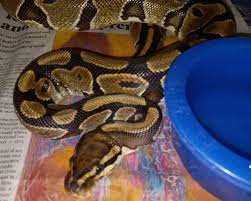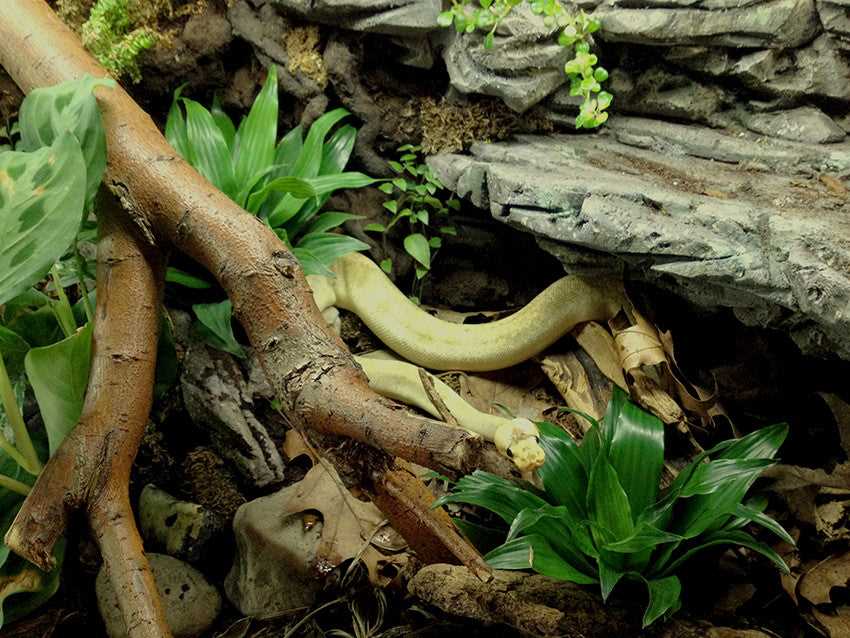
Ball pythons are native to the grasslands and forests of western and central Africa. They are primarily ground-dwelling snakes, but they also enjoy climbing. Providing a variety of climbing opportunities in their enclosure, such as branches or sturdy vines, can help stimulate their natural behaviors and keep them entertained.
Enrichment is an important aspect of keeping any pet happy and engaged, and ball pythons are no exception. One way to provide enrichment is through their substrate. Using a variety of substrates, such as cypress mulch or coconut fiber, can create different textures and smells for your python to explore. This can help keep them mentally stimulated and satisfy their natural instincts.
Another way to enrich your ball python’s life is by providing them with toys and interactive objects. This can include items such as puzzle feeders, which require the snake to work for their food, or snake-safe objects for them to explore and interact with. Just be sure to choose toys that are safe for your python and avoid anything that could pose a choking hazard.
Maintaining a Healthy Diet for Your Ball Python
One important aspect of maintaining a healthy diet for your ball python is to provide appropriate prey items. In the wild, ball pythons primarily feed on small mammals such as mice and rats. As a pet owner, it is crucial to replicate their natural diet as closely as possible.
Lastly, it is essential to monitor the feeding habits and body condition of your ball python. Regularly weigh your snake and look for any signs of malnutrition or obesity. Adjust the feeding schedule and prey size accordingly to ensure the optimal health of your ball python.
Providing a healthy diet for your ball python is crucial for their overall well-being and longevity. By offering appropriate prey items, ensuring the correct size of the prey, and monitoring their feeding habits, you can help your ball python thrive in their enclosure and enjoy a long, healthy life.
Providing Environmental Enrichment for Your Ball Python
Environmental enrichment is crucial for the overall well-being and happiness of your ball python. By creating a stimulating and engaging enclosure, you can help your python thrive both physically and mentally. Here are some key factors to consider when providing environmental enrichment for your python:
1. Enclosure Size and Setup
Ensure that your python’s enclosure is of appropriate size to allow for natural movements. The enclosure should be spacious enough to include a hiding spot, a climbing branch, and a basking area. The recommended size for an adult ball python enclosure is at least 36 inches long, 18 inches wide, and 12 inches tall.
2. Substrate Selection
Choose an appropriate substrate that mimics the natural environment of a ball python. Avoid substrates that can cause harm or are difficult to clean. Some suitable options include aspen bedding, cypress mulch, or paper towel. The substrate should be deep enough for your python to burrow and explore.
3. Providing Climbing Opportunities
Ball pythons are semi-arboreal and enjoy climbing. By adding branches or sturdy vines to the enclosure, you can provide opportunities for your python to exercise and explore. Ensure that the branches are securely placed and are of the appropriate size for your python to safely climb on.
4. Hiding Places

Include multiple hiding spots in the enclosure to provide a sense of security for your snake. Hides can be created using various materials such as caves, logs, or commercial reptile hides. Place the hides in different areas of the enclosure to allow your python to choose a spot that suits its comfort level.
5. Environmental Enrichment Accessories
Consider incorporating additional environmental enrichment accessories such as puzzle feeders, hanging items, or sensory stimulation tools. These can provide mental stimulation and prevent boredom in your python. However, always ensure that any accessories added are safe and do not pose a risk of injury or ingestion.
Remember to regularly assess and rotate the environmental enrichment items in your python’s enclosure to keep its environment fresh and engaging. This will help ensure that your ball python is provided with the necessary mental and physical stimulation for a happy and fulfilling life.
Proper Temperature and Humidity for Ball Python Enclosure
Temperature

Ball pythons are ectothermic, which means they rely on external sources of heat to regulate their body temperature. As a reptile, they need a temperature gradient within their enclosure to thermoregulate properly. The ambient temperature should be maintained between 75-80°F (24-27°C) on the cool side of the enclosure, while the warm side should be around 88-92°F (31-33°C). You can achieve this by using a combination of heat lamps, ceramic heat emitters, or heating pads, depending on your setup and preferences.
Humidity
Proper humidity is also essential for a ball python’s health. In the wild, ball pythons inhabit areas with high humidity levels, and replicating this in captivity is vital. The humidity inside the enclosure should be maintained at around 50-60%. This can be achieved by providing a large water bowl, regular misting or using a humidifier if necessary. Monitoring the humidity levels with a hygrometer is important to ensure they are within the optimal range.
Additional Considerations
The substrate used in the enclosure should also retain moisture well, as this can help maintain the humidity levels. Options such as cypress mulch, coconut husk, or sphagnum moss can be used. Regularly monitoring and adjusting the temperature and humidity levels, as well as providing proper enrichment, can contribute to the overall well-being and comfort of your ball python.
| Temperature: | 75-80°F (24-27°C) on the cool side | 88-92°F (31-33°C) on the warm side |
|---|---|---|
| Humidity: | 50-60% |
Regular Handling and Socialization
Regular handling and socialization are essential aspects of keeping a ball python as a pet. Interacting with your snake regularly helps to build trust and reduce stress, which can greatly improve their overall quality of life.
Toys can also be introduced to stimulate your ball python’s senses and provide mental stimulation. This can include objects that they can interact with, such as PVC pipes or empty toilet paper rolls. Just be sure to monitor your snake while they are playing with toys to ensure they do not accidentally ingest them.
In summary, regular handling and socialization of your ball python can greatly enhance their overall well-being. Providing climbing branches, hiding spots, a variety of substrates, and toys within their enclosure allows them to engage in natural behaviors and mental stimulation. Just remember to approach your snake calmly and respect their individual preferences for handling and interaction.
Monitoring and Treating Health Issues
Monitoring the health of your ball python is crucial in ensuring its well-being. Regularly observing your snake for any signs of illness or injury is essential for early detection and treatment. Here are some important factors to consider when monitoring and treating health issues in your ball python:
1. Observation and Evaluation
2. Maintaining Cleanliness
Keep the enclosure of your ball python clean and hygienic. Regularly clean and disinfect the habitat, including all accessories and substrates. Proper hygiene helps prevent the spread of bacteria and parasites that can cause health issues for your snake.
3. Quarantine New Additions
If you bring a new ball python into your collection, it is essential to quarantine them before introducing them to your existing snakes. This will help prevent the spread of any potential diseases or parasites, allowing you to monitor the new snake’s health before introducing them to others.
4. Consulting a Herp Veterinarian

If you notice any concerning signs or symptoms, it is advisable to consult a veterinarian experienced in reptile care. They can provide a proper diagnosis and recommend appropriate treatment options for your ball python.
5. Medications and Treatments
6. Prevention Measures
Prevention is key to maintaining your ball python’s health. Provide a clean and stress-free environment, ensure proper temperature and humidity levels, offer a balanced diet, and provide environmental enrichment. Regularly inspect and maintain the enclosure to avoid any potential hazards or health risks.
By following these guidelines and seeking veterinary care when needed, you can help ensure the health and well-being of your ball python for years to come.
